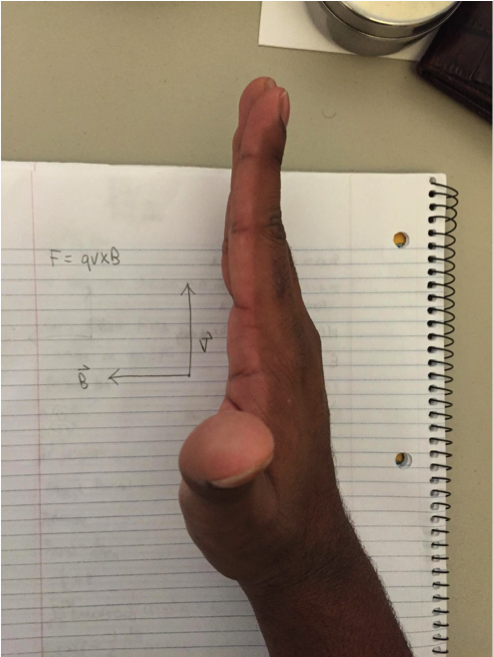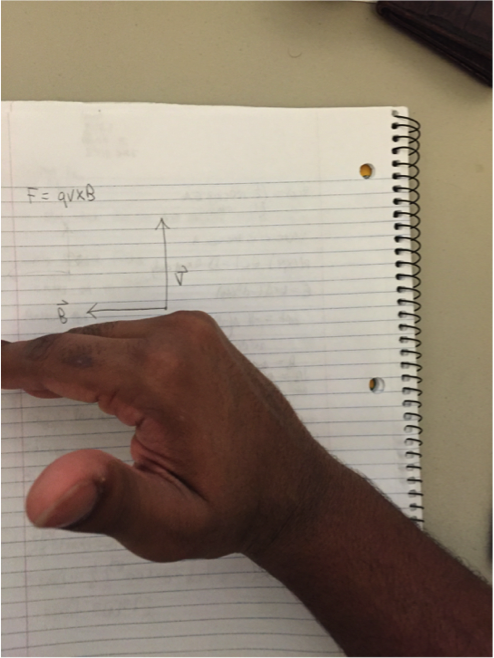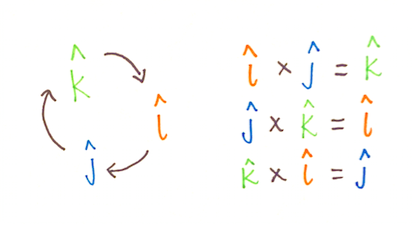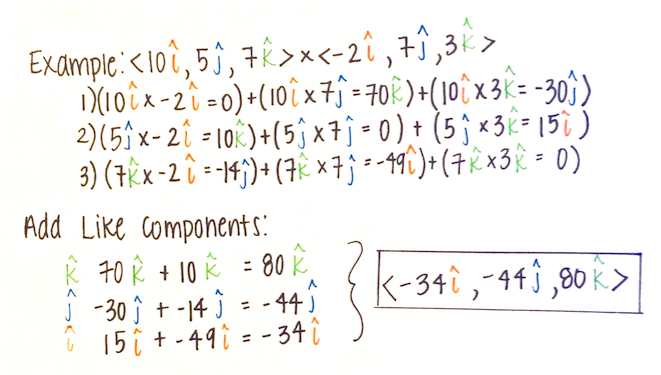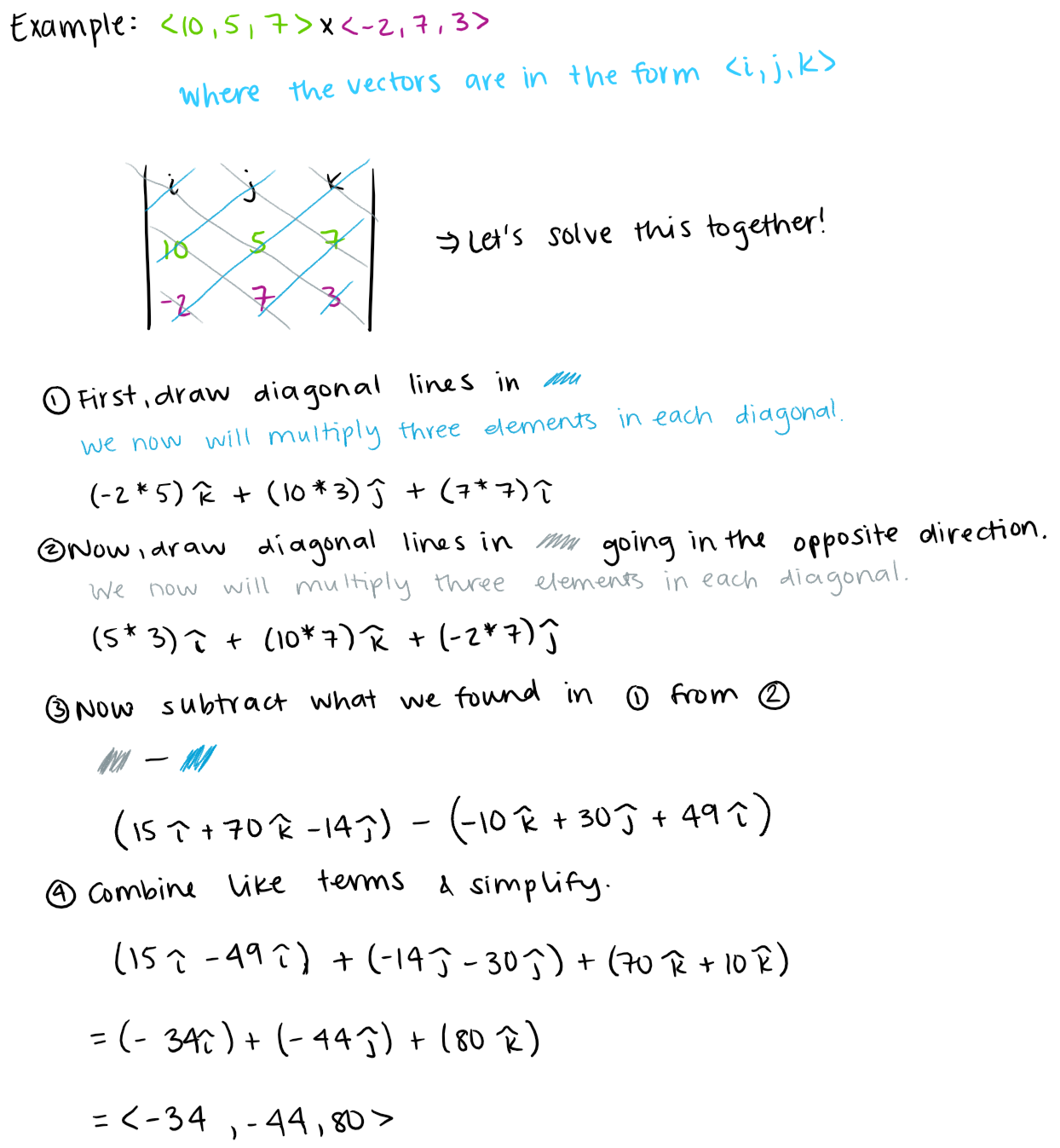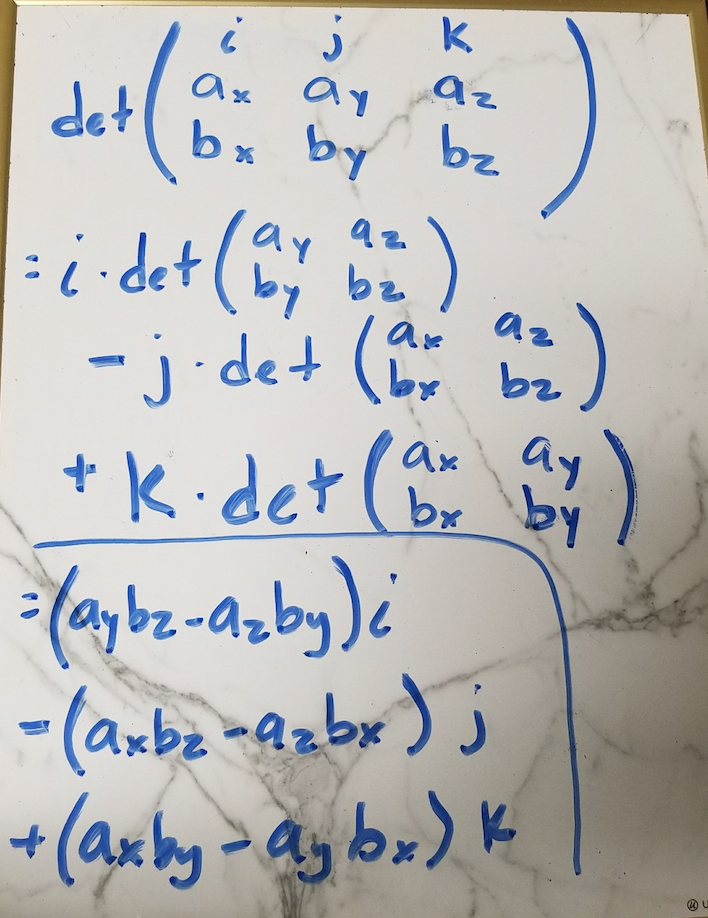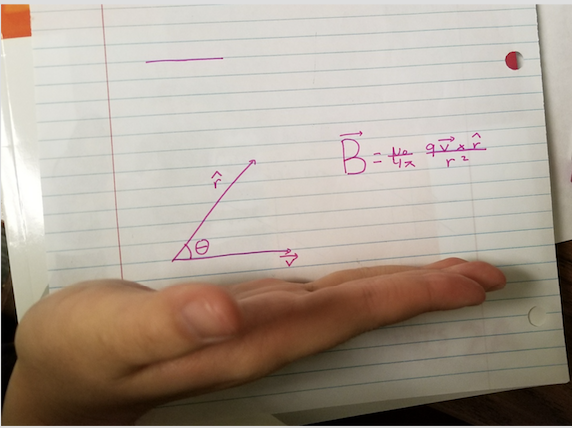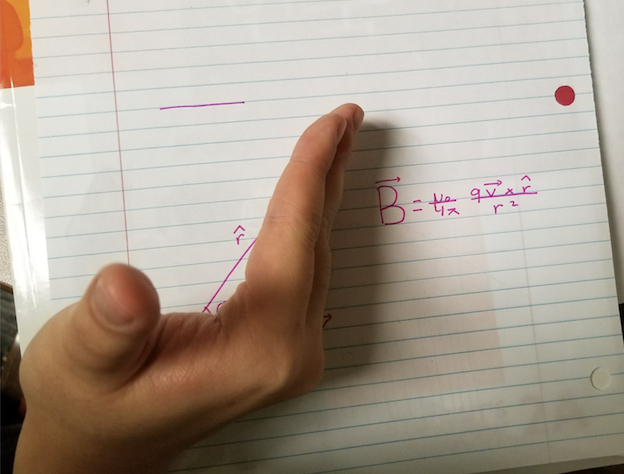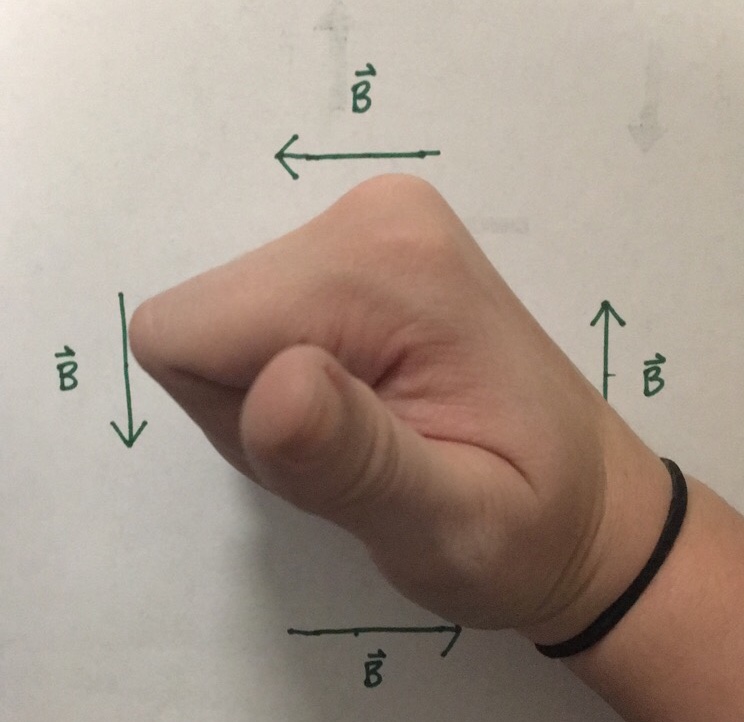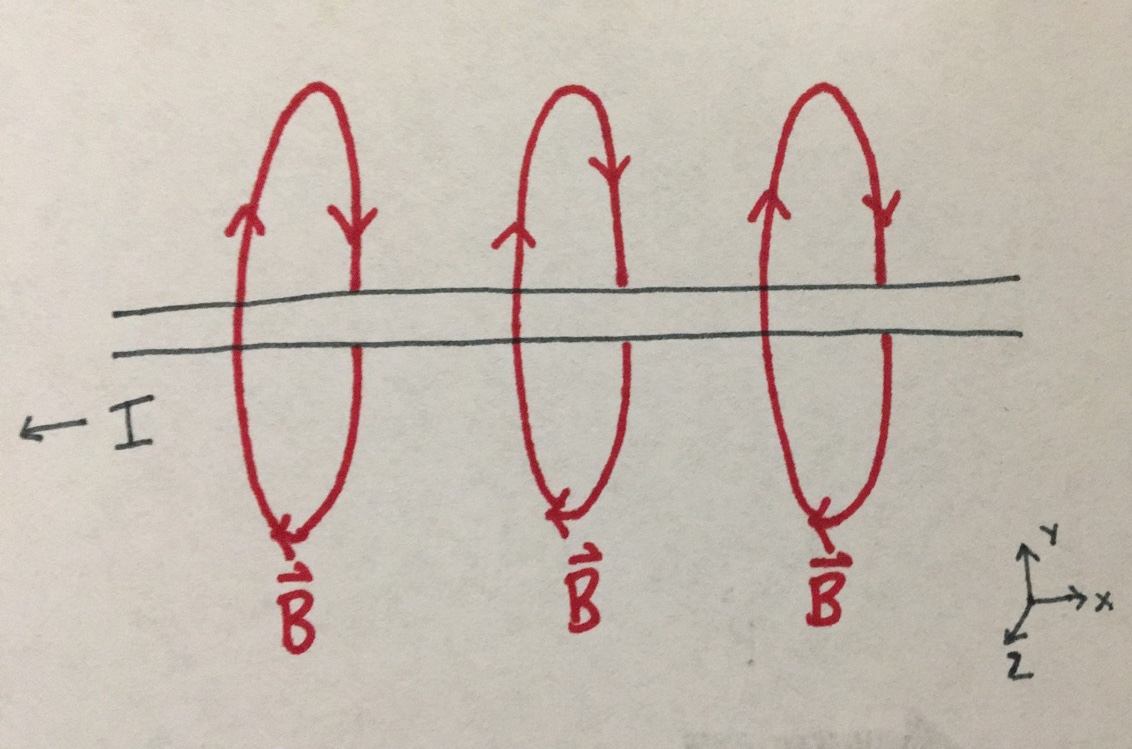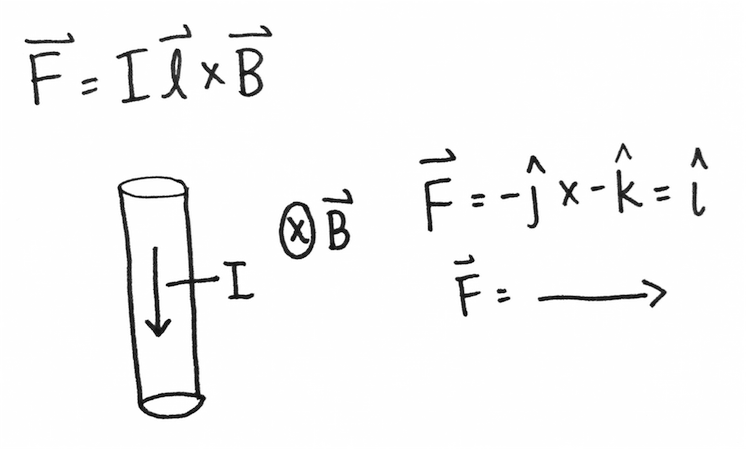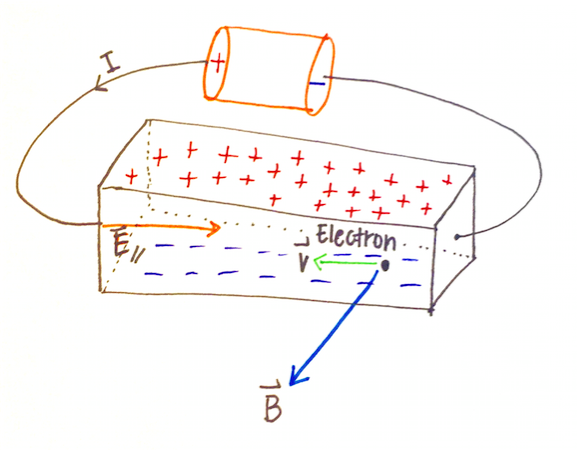Right-Hand Rule
Claimed by Leah Charity-Spriggs Fall 2025
The Main Idea
The Right-Hand Rule is an easy way to find the direction of a cross product interaction before doing the math. For any equation involving a cross product, the right hand rule is a valuable tool for finding the direction. There are two primary ways of using the right hand rule.
1) The first method is to use your entire right hand. Make shape of a high five with your right hand with your right hand, with your thumb sticking out perpendicular to the direction of your fingers. Align your hand with the first vector listed in the cross product. Then, curl your fingers toward the second vector listed in the cross product without moving your palm. You must rotate your hand to whatever orientation it requires for this to be possible, while keeping your thumb perpendicular to your fingers through the entire process. Your thumb will point in the direction of the cross product. In the example depicted below the cross product points "out" of the page, the same direction as the thumb.
2) The second method is extremely similar to the first. Start by making a thumbs up, and maintain your thumb extended in this way through the entire process. Extend your index (pointer) finger and align it with the first vector in the cross product. Extend your middle finger and align it with the second vector while keeping your ring and pinkie fingers closed. This will force you to orient your hand in such a way that your thumb will point in the direction of the cross product. This is demonstrated below.
A Mathematical Model
The Right-Hand Rule is a technique for modeling the direction of a cross product:
- [math]\displaystyle{ \mathbf{u\times v}=(u_2v_3\mathbf{i}+u_3v_1\mathbf{j}+u_1v_2\mathbf{k}) -(u_3v_2\mathbf{i}+u_1v_3\mathbf{j}+u_2v_1\mathbf{k}) }[/math]
The cross product can also be solved in the following form (using u and v):
- [math]\displaystyle{ | \mathbf{u} \times \mathbf{v} | = | \mathbf{u} | | \mathbf{v} | \sin (\theta) }[/math]
Cross Product: Alternate Method 1
Alternate methods for computing a cross product exist, though this one is limited to cross products of 3 dimensions.
Structure the three components in a circle and assign a clockwise direction around this circle.
Crossing one component with another component that can be reached clockwise on on the next move around the circle yields a vector third direction.
This can be seen in the picture below.
In order to quickly solve a cross product using this alternate method, see the following example.
Note: order matters in cross products. When crossing two vectors in the counter-clockwise direction the resulting third vector is negative.
Cross Product: Alternate Method 2
Cross Product: Alternate Method 3
If you're personally more of a math person, and you have taken linear algebra or have done determinants before, cross products are essentially taking determinants of a 3x3 matrix.
1. For the first row, write down i, j, k. These are your directional components with "i" representing the +x direction, "j" the +y direction, and "k" the +z direction.
2. If you are crossing a x b, write down the a components in the second row and b components in the third row corresponding to the x,y,z direction. If for example, ax is in the -x direction, simply make the value of ax negative.
3. Then take the determinant of the 3x3 matrix which is shown below. Don't forget that the second term (j) must be negative.
Common Mistakes
1)Using the left hand by accident, which reverses the direction completely.
2)Pointing your fingers in the wrong order (cross products are not commutative)
3)Trying to curl fingers backwards instead of rotating your hand first.
4)Forgetting to flip the direction for negative charges.
5)Assuming the magnitude comes from the right-hand rule (it only gives direction).
6)Mixing up magnetic field from current and force on current.
When RHR doesn't work
For scalar products like work, divergence, dot products.
For electric fields on charges (that uses Coulomb's law, not RHR).
For non-vector interactions (ex: torque without defining the axis).
For 2D problems with no 3D component (students try to force a cross product where it isn’t needed).
Practice Problems
A proton moves north while the magnetic field points west. What is the direction of the magnetic force?
A wire carries current upward. What direction is the magnetic field 2 cm east of the wire?
An electron moves east and experiences a force upward. What direction is the magnetic field?
Compute ⟨2,−1,3⟩×⟨0,4,−2⟩.
A current loops clockwise when viewed from above. What direction is its magnetic dipole vector?
RHR in 3d visualizations
If you were wondering, "how does the RHR relates to coordinate systems?", here are some examples:
RHR is built into the structure of the 3D coordinate system (x cross y = z).
Explains why physics uses right-handed coordinates instead of left-handed ones.
Mention that computer graphics sometimes use left-handed systems and must convert.
Helpful Memory Tricks
“Palm → first vector, curl → second vector, thumb → result.”
“If curling your fingers feels impossible, rotate your wrist — not the vectors.”
“Thumb direction is always the axis of rotation (righty-tighty).”
A Computational Model
For a computational model, the Right-Hand Rule is just an easy way to determine the direction of the result of a cross product, but the model below allows you to change the two initial vectors, which the cross product will react to, and it will show that the right hand rule is true for any set of vectors that are not facing the same direction. (Note: Just because you can determine the direction of a cross product using the RHR does NOT mean that every equation involving cross products will end up with that direction. Please make sure to account for any changes in sign, magnitude, or direction when solving cross product equations.
<html> <iframe src="https://trinket.io/embed/glowscript/746a15552f" width="100%" height="356" frameborder="0" marginwidth="0" marginheight="0" allowfullscreen></iframe> <html>
Examples
Magnetic Field for a Point Charge (Bio-Savart Law)
The equation written in pink in the picture below is the Bio-Savart Rule for a single charged particle which will be later explained in further chapters. As you can see, there is a cross product within the equation, and it can be a little tricky finding the direction of the magnetic field.
Using the Right-Hand rule (alternative 2):
1. place your palm in the direction of velocity since it is velocity crossed rhat
2. curl your finger to the direction of rhat
3. Point your thumb up( perpendicular from your fingers) and this direction is the direction of your magnetic field, assuming that the charge is positive.
If your charge is negative, then simply flip the direction of your thumb.
In the picture below, the direction of the magnetic field would be out of the page (+z) if the particle is positively charged. If the charge was an electron (negatively charged), then the direction of the magnetic field would be into the page (-z).
Magnetic Force on a Moving Particle
- [math]\displaystyle{ \mathbf{F} = q\mathbf{v} \times \mathbf{B} }[/math]
The direction of the cross product may be found by application of the right hand rule as follows:
- The index finger points in the direction of the momentum vector qv.
- The middle finger points in the direction of the magnetic field vector B.
- The thumb points in the direction of magnetic force F.
For example, for a positively charged particle moving to the right, in a region where the magnetic field points up, the resultant force points out of the page (+z). If it was the same situation, but the particle was negatively charged, the you would flip the direction of your thumb, and the resultant force points into the page (-z).
Magnetic Field made by a Current
- [math]\displaystyle{ \mathbf{B} = \frac{\mu_0I}{4\pi}\int_{\mathrm{wire}}\frac{\mathrm{d}\boldsymbol{\ell} \times \mathbf{\hat r}}{r^2}, }[/math]
The direction of the cross product may be found by application of the right hand rule as follows:
- The thumb points in the direction of current I.
- The index finger points in the direction of the observation vector r.
- The middle finger points in the direction of the magnetic field vector B.
Direction of Magnetic Field made by a Current
The direction of curl of the magnetic field can be found using a modified right hand rule:
- The thumb points in the direction of conventional current.
- The curl of the fingers indicates the direction of magnetic field at each location surrounding the flow of current.
For example:
- In the image below, conventional current flows to the left (-x). By pointing your thumb in the -x direction and curling your fingers, the magnetic field curls in the y,z-plane, as shown.
Force on a Current from a Magnetic Field
- [math]\displaystyle{ \mathbf{F} = \mathbf{I} \times \mathbf{B} }[/math]
The direction of the cross product may be found by application of the right hand rule as follows:
- The index finger points in the direction of the current I.
- The middle finger points in the direction of the magnetic field vector B.
- The thumb points in the direction of magnetic force F.
For example, for a current moving into the page, in a region where the magnetic field points up, then the force is to the right of the current.
Another Force on a Current from a Magnetic Field
In the situation shown below, we have a current pointing downward or in the negative y direction and we have a magnetic field into the page or in the negative z direction. Instead of using the typical right hand rule, we can use easy cross product method below to find the direction of the force.
Hall Effect Example
In the above picture, you see that all the positive charges accumulated at the top and all the negative charges accumulated to the bottom. You know the direction the particles velocity and magnetic field. Can you find out the charge of the particle using the right hand rule?
In the picture, the particles are coming out of the negative terminal, so they are electrons. This can be verified by using the right hand rule. You curl your fingers from velocity vector to magnetic field vector to find the direction of magnetic force perpendicular. Your thumb is pointing up, but since these are negative charges, its opposite and you flip your hand and you find that the direction of the magnetic force is actually pointing down. Therefore it makes sense that the electrons would accumulate at the bottom since its magnetic force is pushing them towards there.
Applications in Modern Technology
The right-hand rule isn’t just a physics classroom trick—it underpins the functionality of numerous modern technologies. For example, electric motors and generators operate directly based on the principles of electromagnetism, where magnetic fields and currents interact to produce motion or induce voltage. In a DC motor, the current flows through coils situated in a magnetic field. The force exerted on these coils due to the magnetic field (as determined by the right-hand rule) causes them to rotate, converting electrical energy into mechanical work. Conversely, in a generator, mechanical rotation in a magnetic field generates a current, again aligning with the right-hand rule but in reverse.
Another major application is in the field of particle accelerators and mass spectrometers, where charged particles are manipulated using magnetic fields. Engineers and physicists use the right-hand rule to design magnetic steering systems that control the trajectory of high-speed electrons, protons, or ions. Accurate directional control is essential, as even the smallest miscalculation in the force vector can cause particles to crash into containment walls or skew the results of delicate experiments.
Additionally, magnetic resonance imaging (MRI) systems use rapidly changing magnetic fields to align and detect the spin of atomic nuclei in the human body. The right-hand rule helps explain how the magnetic fields interact with current-carrying wires in the machine’s gradient coils to produce spatially varying fields. These interactions are critical for encoding location information in the resulting medical images, showcasing how a basic vector rule plays a role in saving lives.
The right-hand rule is also crucial in aerospace and satellite engineering, where magnetic torquers are used for attitude control of satellites. These torquers generate magnetic dipoles that interact with Earth’s magnetic field to produce torque, allowing engineers to rotate or stabilize satellites without using fuel. To predict and control these rotational effects accurately, the right-hand rule helps determine the direction of torque from the interaction between the satellite’s internal current loops and Earth’s geomagnetic field. This method of non-propulsive control is lightweight, reliable, and energy-efficient, making it ideal for long-duration missions in low Earth orbit.
Connectedness
1. How is the topic connected to something you are interested in?
It's honestly a valuable tool in determining the direction of cross-products which allows me to see if my math is correct. For example, to figure out the direction of the conventional current that flows in a wire whose magnetic field changes the direction of a compass, I would have the use the right-hand rule to help me out.
If a charged particle is moving at a certain speed and is under a magnetic field, the right-hand rule can be used to determine the force the particle will experience.
2. How is it connected to your major?
As a Biomedical engineering major, it is relevant in my statics class, and although we don't see the right hand rule in action first-hand, I know it plays a critical role in what we do when we're taking moments about a point and can be used to explain why certain moments are positive versus negative.
3. Is there an industrial application?
Using sails for a boat deals with cross-product because when the wind blows, the sails experience angular momentum L = I x w
History

John Ambrose Fleming is credited with devising the right-hand rule. He was a professor at the University College, London where he was liked by many of his students. Fleming devised the right hand rule (though Fleming's original version used the left hand) in order to make relationships between current, its magnetic field, and the electromotive force easier to visualize and understand.
Though he was best known for his right-hand rule in which he connected the observation vector, magnetic field, and current, he also had a left-hand rule as well which he used for motors. It connected force, magnetic field, and current.

See Also
External Links
- https://www.khanacademy.org/test-prep/mcat/physical-processes/magnetism-mcat/a/using-the-right-hand-rule
- https://ocw.mit.edu/courses/physics/8-02t-electricity-and-magnetism-spring-2005/lecture-notes/prs_w06d1.pdf
- http://physics.bu.edu/~duffy/semester2/d12_RHR_practice.html
